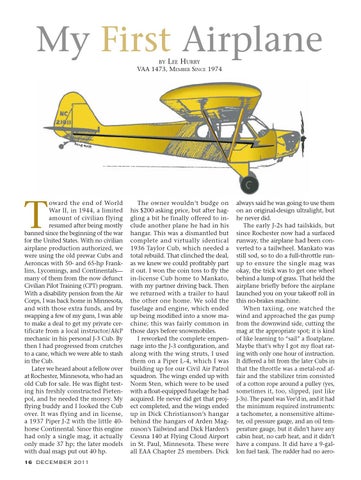My First Airplane BY
LEE HURRY
VAA 1473, MEMBER SINCE 1974
T
oward the end of World War II, in 1944, a limited amount of civilian flying resumed after being mostly banned since the beginning of the war for the United States. With no civilian airplane production authorized, we were using the old prewar Cubs and Aeroncas with 50- and 65-hp Franklins, Lycomings, and Continentals— many of them from the now defunct Civilian Pilot Training (CPT) program. With a disability pension from the Air Corps, I was back home in Minnesota, and with those extra funds, and by swapping a few of my guns, I was able to make a deal to get my private certificate from a local instructor/A&P mechanic in his personal J-3 Cub. By then I had progressed from crutches to a cane, which we were able to stash in the Cub. Later we heard about a fellow over at Rochester, Minnesota, who had an old Cub for sale. He was flight testing his freshly constructed Pietenpol, and he needed the money. My flying buddy and I looked the Cub over. It was flying and in license, a 1937 Piper J-2 with the little 40horse Continental. Since this engine had only a single mag, it actually only made 37 hp; the later models with dual mags put out 40 hp.
16 DECEMBER 2011
The owner wouldn’t budge on his $200 asking price, but after haggling a bit he finally offered to include another plane he had in his hangar. This was a dismantled but complete and virtually identical 1936 Taylor Cub, which needed a total rebuild. That clinched the deal, as we knew we could profitably part it out. I won the coin toss to fly the in-license Cub home to Mankato, with my partner driving back. Then we returned with a trailer to haul the other one home. We sold the fuselage and engine, which ended up being modified into a snow machine; this was fairly common in those days before snowmobiles. I reworked the complete empennage into the J-3 configuration, and along with the wing struts, I used them on a Piper L-4, which I was building up for our Civil Air Patrol squadron. The wings ended up with Norm Sten, which were to be used with a float-equipped fuselage he had acquired. He never did get that project completed, and the wings ended up in Dick Christianson’s hangar behind the hangars of Arden Magnuson’s Tailwind and Dick Harden’s Cessna 140 at Flying Cloud Airport in St. Paul, Minnesota. These were all EAA Chapter 25 members. Dick
always said he was going to use them on an original-design ultralight, but he never did. The early J-2s had tailskids, but since Rochester now had a surfaced runway, the airplane had been converted to a tailwheel. Mankato was still sod, so to do a full-throttle runup to ensure the single mag was okay, the trick was to get one wheel behind a lump of grass. That held the airplane briefly before the airplane launched you on your takeoff roll in this no-brakes machine. When taxiing, one watched the wind and approached the gas pump from the downwind side, cutting the mag at the appropriate spot; it is kind of like learning to “sail” a floatplane. Maybe that’s why I got my float rating with only one hour of instruction. It differed a bit from the later Cubs in that the throttle was a metal-rod affair and the stabilizer trim consisted of a cotton rope around a pulley (yes, sometimes it, too, slipped, just like J-3s). The panel was Vee’d in, and it had the minimum required instruments: a tachometer, a nonsensitive altimeter, oil pressure gauge, and an oil temperature gauge, but it didn’t have any cabin heat, no carb heat, and it didn’t have a compass. It did have a 9-gallon fuel tank. The rudder had no aero-
